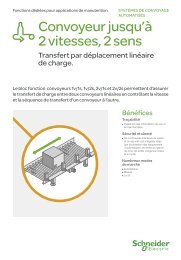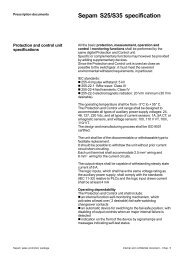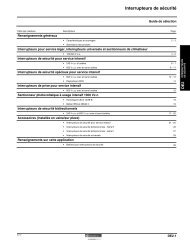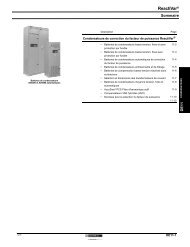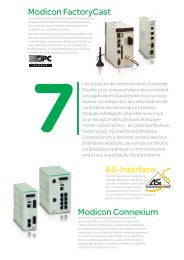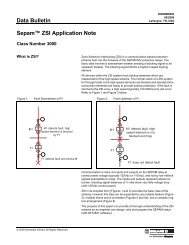Download - Schneider Electric
Download - Schneider Electric
Download - Schneider Electric
You also want an ePaper? Increase the reach of your titles
YUMPU automatically turns print PDFs into web optimized ePapers that Google loves.
TeSys<br />
Elevator and Safety Applications<br />
Standard TeSys products can be used for elevator and safety applications when applied as followings:<br />
Elevator approvals per CSA22.2 / CSA B44.1 / ASME 17.5<br />
File LR43364<br />
Single Phase<br />
240V<br />
Three Phase<br />
200/208V 230/240V 480V 600V TeSys Series Previous Generation<br />
4<br />
1.5 2 3 7.5 7.5 LC1D12 LC1DFD**<br />
3 5 7.5 15 20 LC1D25 LC1DLD**<br />
5 10 - - - LC1D32<br />
7.5 - 15 25 30 LC1D50 LC1DRD**<br />
10 - 20 40 50 LC1D65 LC1DTD**<br />
15 - 25 50 50 LC1D80 LC1DWD**<br />
15 - 30 60 50 LC1D150<br />
20 30 30 75 75 LC1F185 LC1FGD3<br />
- 40 40 - - LC1F265<br />
- 50 50 - - LC1F330<br />
- 60 60 - - LC1F400<br />
- 75 75 - - LC1F500<br />
- 100 100 - - LC1F630<br />
Contactors in Safety Circuits<br />
Contactors are an integral part of safety applications. <strong>Schneider</strong> <strong>Electric</strong> offers a wide variety<br />
of contactors which are suitable for use in safety applications due to mechanically linked power<br />
contacts and mirror contacts.<br />
A number of standards have been published in recent years that use the concept of functional<br />
safety. Examples include IEC 61508, IEC 62061, IEC 61511, ISO 13849-1, and IEC 61800-5-2<br />
which have all been adopted in Europe and published as ENs. Functional safety is a relatively<br />
recent concept that replaces the old `Categories' of behavior under fault conditions that were<br />
defi ned in EN 954-1, and were often mistakenly described as `Safety Categories'.<br />
Now that EN 954-1 is withdrawn, the available alternatives are EN 62061 and EN ISO 13849-1.<br />
The performance of each safety function is specified as either a SIL (Safety Integrity Level) in<br />
the case of EN 62061 or PL (Performance Level) in the case of EN ISO 13849-1. In both cases<br />
the architecture of the control circuit which delivers the safety function is a factor, but unlike<br />
EN 954-1 these new standards require consideration of the reliability of the selected components.<br />
In the past there has been a tendency for components specified to a high category of EN 954-1<br />
to be chosen instead of components that have a lower category, but might actually have more<br />
suitable functions. This might be as a result of the misconception that the categories are<br />
hierarchical such that for example, category 3 is always “better” than category 2 and so on.<br />
Functional safety standards are intended to encourage designers to focus more on the functions<br />
that are necessary to reduce each individual risk, and what performance is required for each<br />
function, rather than simply relying on particular components.<br />
For more information on Functional Safety, please visit our web site at:<br />
www.schneider-electric.com under: Solutions > Machines for OEMs > Machine control solutions<br />
34<br />
4/34<br />
Other versions: please consult our Customer Care Centre.



